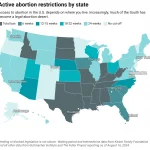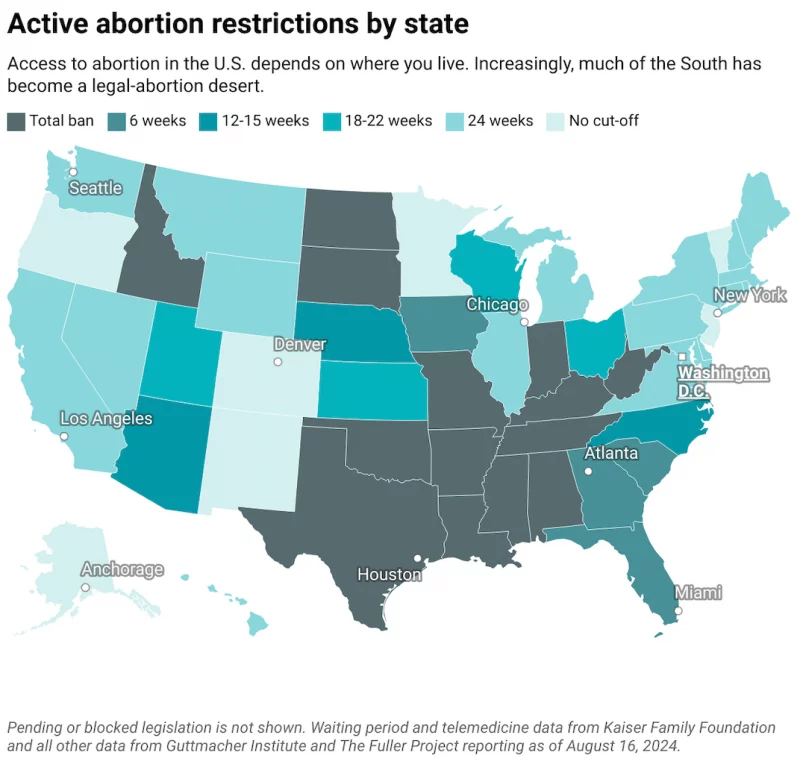~ PUREGNS~ First, the biggest issue I see is the total ignorance of the current Abortion situation.
When Roe vs. Wade as a national law was overturned, it was sent to each state to determine each State’s policy on Abortion.
Reversing the Roe vs. Wade decision is the best thing for women’s rights. However, due to so much misinformation this issue is mute among many women pushing for their rights.
Quit fighting this at a national level and go to your state to push for your rights!
Marching for women’s rights with your pink vagina hats is not helping anything.
Abortion Laws by State – Center for Reproductive Rights
(Go to the website to see each State’s current Law)
After Roe Fell: Abortion Laws by State
In June 2022, the U.S. Supreme Court overturned Roe v. Wade, opening the door for states to ban abortion outright. Since the decision, 14 states have made abortion illegal.
“After Roe Fell: Abortion Laws by State” examines laws, constitutions, and court decisions on abortion—and assigns each state, territory, and the District of Columbia to one of five categories: Expanded Access, Protected, Not Protected, Hostile, and Illegal.
Abortion laws by state, mapped (axios.com)
How late into pregnancy abortion is legal
As of July 25, 2024
Six weeks or earlier (18 states)12 to 15 weeks (3)18 to 22 weeks (4)24 weeks or later (18)No defined limit (8)
Choropleth map showing that 18 states ban abortion at six weeks or earlier and seven states ban abortion at 12 to 22 weeks. 18 states allow abortion up until 24 weeks or later and eight states have no defined limit on abortion.
State laws surrounding abortion have been in flux since since the Supreme Court overturned Roe v. Wade nearly two years ago.
The big picture: The battle over abortion access remains in some states, where anti-abortion and pro-choice advocates are engaged in a tug-of-war over the specific legalities and limits of the procedure.
- The Iowa Supreme Court ruled in late June that a ban on most abortions after six weeks of pregnancy will take effect by mid-July.
- A six-week ban on the procedure took effect in Florida in May, but abortion rights will be back on ballots in the state this November.
Meanwhile, more than 1 million abortions took place in the U.S. health care system last year. That’s the highest number in more than a decade, per the Guttmacher Institute, a research organization that supports abortion rights.
Zoom in: States vary on the gestational limits of abortion, but 14 states have laws in effect banning nearly all abortions starting at fertilization.
- Six weeks: Florida, South Carolina and Georgia are the only states that have laws in effect banning abortions when cardiac activity has been detected in an embryo, which is at around six weeks.
- 12 weeks: Nebraska and North Carolina are the two states that currently ban abortion at the 12-week mark.
- 15 weeks: Arizona currently bans abortion at 15 weeks. The state Supreme Court in April upheld a near-total abortion ban, but Gov. Katie Hobbs signed a bill in May to repeal it. The move will allow a 2022 law permitting abortions through 15 weeks of pregnancy to take effect. However, since the repeal will not take effect until at least Sept. 26, the near-total ban may be enforced this summer.
- 18 weeks: Utah is the only state that currently bans abortion at 18 weeks of pregnancy.
- 20 weeks: Iowa bans abortion starting at 20 weeks post-fertilization.
- 22 weeks: Kansas and Ohio ban abortions at 22 weeks of pregnancy.
In Wisconsin, abortions are banned at 20 or more weeks postfertilization (22 weeks after the last menstrual period).
Zoom out: More than half of states have restrictions in place only at or after viability, or have no limit at all.
- 24 weeks or later: Four states ban abortions starting at 24 weeks of pregnancy.
- Viability: More than a dozen states ban abortions after the fetus is considered viable. Some laws that don’t specify a limit say it’s up to the abortion provider’s “judgment” to determine whether a fetus is viable.
- Third trimester: Virginia is the only state that prohibits abortions starting in the pregnancy’s third trimester, which starts at around 25 weeks, per Guttmacher.
No limit: Six states and Washington, D.C., do not impose any term restrictions.
Of note: Most states with restrictions have exceptions, including to preserve a pregnant person’s life or health, though they are often narrowly defined.
- The Texas Supreme Court in late May unanimously rejected a lawsuit over abortion ban exceptions.
Here’s where the 2024 presidential candidates stand on abortion – ABC News (go.com)
Kamala Harris
After Roe was struck down, Harris led the Biden administration’s charge to protect reproductive rights. She toured the country advocating for abortion access, including a first-of-its-kind visit to an abortion clinic for any vice president.
Harris has called on Congress to pass a law restoring protections to the right to abortion that were guaranteed by Roe, saying she would “proudly” sign it if it came to her desk.
When announcing her running mate, Minnesota Gov. Tim Walz, she praised his state for being the first in the country to pass a law codifying abortion rights after Roe was overruled.
She’s been critical of abortion restrictions passed by Republican-led states in recent years and has tied the fall of Roe to Trump after he appointed three Supreme Court justices to the court who supported overruling the landmark abortion decision.






































































